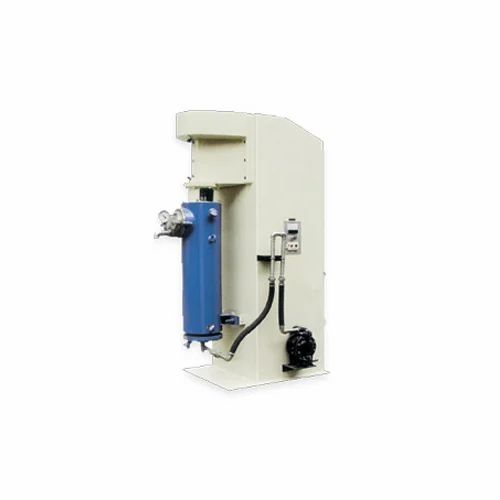Sand Mill
Used mainly by the paint, ink & coating industries for size reduction and dispersing of pigments in liquids. Particle size reduction upto 2 microns is possible in a single pass. The material to be processed is pumped from the bottom of the mill into the milling chamber which is filled with grinding media of 3mm dia. The media is agitated by a shaft fitted with a number of impeller discs along its length. As the material moves upwards it is subjected to high hydraulic & shearing forces between the grinding media which results in fine grinding of the material. This material then passes through the screen which separates the media from the process material. All mills are provided with a jacket arrangement for cooling the material in the grinding chamber.
OPTIONAL
Grinding Media.
Pressurized Mills.
AGITATOR SAND MILLS: Are Designed For The Processing Of High Viscosity Offset Inks. The Mill Continuously Processes T he Pr-Dispersed Printing Inks In Conjunction With An Intermediate Storage Tank. The Application Specific Design Has Been Optimized For Processing Chocolate, Paints, Liquid Printing Inks, And Pigments.
SAND MILL WORKING PRINCIPLES
: Continuously Processes The Pre-Dispersed Printing Ink In Conjunction With An Intermediate Storage Tank, Pr-selected Parameters Are Held Constant During The Entire Operational Period Guaranteeing That The Best Possible Throughput Rate Is Set.
FEATURES AND BENEFITS OF SAND MILL
High Grinding Efficiency, Enclosed Design, Double-Acting Mechanical Seal, Optimal Adjustment Of Bead Charge, Wear-Resistant Grinding Chamber, Integrated Lifting Device, Multiple Cooling, Our Pearl Mill Has Special Rotor Design For Use With Media Larger Than 6 mm
SAND MILL model—– having the total volume of grinding cylinder Liters, with having the continuous output of — to — Liters Per/Min. This machine is suitable for grinding low medium high viscosity material between 100 CPS and 4000 CPS thixotropics and product with highly pigmented systems. This machine will have the following items.
Sturdy Mild Steel Fabricated Body For The Mill.
Stainless Steel 304 Grinding Cylinder With Mild Steel Water Cooling Jacket For Sand Mill, & For Pear Mill Stainless Steel 304 Jacket Having Cooling Efficiency Is Enhanced Through A Two-Zone Spiraled Jacket. The Spiral Design Creates These Desired Effects: Cooling To The Entire Chamber; Greater Temperature Control Due To Increased Surface Area; And Reduced Pressure Drop By The Use Of Two Inlet And Discharge Ports.
Main Shaft Will Be Stainless Steel 304 With S.S.304 Sleeves.
Range Of Grinding Disc Available Will Be Of Special Wear-Resistant Steel, Hardened Chrome Steel Discs, Stainless Steel (304 Or 316), Hastelloy C, Polyurethane, UHMW Polyethylene, Polyamide (Nylon®), Aluminum Oxide, Zirconium Oxide, Silicon Nitride.
The disc milling systems are primarily used for processing low to medium viscosity (1 to 200 poise) formulations. Solids levels in paint applications have been as high as 85% for industrial and furniture paints and ceramic slurries or slips. These systems are available in both horizontal and vertical configurations
Heavy Duty Bearings For Main Counter Shaft.
The Above Drive Is Provided With Imported Self-Aligned Bearings To Withstand High Speed And Initial Torque Of The Mill.
Main Drive Motor Will Be — HP TEFC/FLP 1440 RPM, 3ph, 440 V, Motor.
—–KGS Glass Beads Will Be Supplied With The Mill For Initial Charge.
Fully Automatic Star Delta Starter For Main And D.O.L. For Feeding Pump.
Hence Complete With Material As Per Our Standard Design.
Capacity Table of Sand mill
|
MODEL NO |
CONTAINER |
MAIN MOTOR HP |
FEEDING PUMP |
FLOW RATE/HR. |
|
SM-4 |
16 |
10 |
1 |
75 |
|
Sm-6 |
32 |
15 |
2 |
300 |
|
SM-8 |
64 |
20 |
2 |
500 |
|
SM-16 |
120 |
30 |
2 |
800 |
What is Vertical sand mill?
The vertical sand mill is the earliest sand mill used and is still widely used today.
Working principle of sand mill
The vertical sand mill is mainly composed of a jacketed cylinder, a dispersing shaft, a dispersing disc and a balance wheel.
Install several (such as 8 to 10) dispersing discs on the dispersing shaft. The balance wheel at the lower end of the shaft plays a certain stabilizing role in the dispersing shaft. However, some sand mills do not use a balance wheel. In the simplified version, add an appropriate amount of glass beads or other grinding medium.
The pre-dispersed paint slurry is fed from the bottom of the cylinder with a feeding pump, and the flow rate of the feeding pump can be adjusted. The bottom valve is a special one-way net that prevents glass beads from flowing back into the pipeline and feed pump after the pump is stopped. Once the paint slurry is fed in, the sand mill is started immediately, and the dispersing shaft drives the dispersing disc to rotate at high speed. The peripheral speed of the outer edge of the dispersing disc reaches about 10m/s (the dispersing shaft speed varies depending on the size of the fractional disc: usually in the range of 600~1500r/min. domestic). The paint slurry and glass beads close to the surface of the dispersion disc are driven by the viscosity resistance as the dispersion disc rotates, thrown to the simple wall of the sand mill, and then returned to the center area. The overall turbulent flow pattern formed at this time can be roughly described as a double-ring rolling pattern. This double-ring rolling produces good grinding and dispersing effects, especially near the surface of the dispersion disc and the area between the outer edge of the dispersion disc and the cylinder wall. During the rising process, the paint slurry rotates multiple times between the two dispersion plates and performs highly turbulent motion. The pigment particles are sheared and impacted by high-speed moving glass beads here, causing the pigments to disperse in the paint. The dispersed paint slurry overflows from the outlet through the screen, and the glass beads are trapped by the screen.
The working efficiency of the sand mill is high, many times higher than that of the ball mill. The reasons are: first, because the grinding medium obtains a high speed (about 10m/s) in the sand mill, so the centrifugal force acting on the grinding medium sphere It is dozens or even more than a hundred times greater than gravity, causing the collision and friction between the spheres to produce strong impact and shear effects. Second, although the diameter of the grinding media spheres is very small (mostly 1~3mm), their number is very large. Therefore, there are many contact points where the grinding media collide with each other in the unit volume of the cylinder. Countless small balls moving at high speed are working hard, so the efficiency of the whole machine is naturally very high.
If the paint slurry still does not reach the required fineness after being dispersed once, the paint slurry flowing into the paint slurry tank can be pumped back to the sand mill for further dispersion until it is qualified. Several sand mills can also be installed in series so that the paint slurry can reach the required fineness in one pass.
The paint slurry is vigorously stirred by grinding media such as dispersing discs and glass beads in the sand mill, which will inevitably cause the temperature to rise and cause the solvent to volatilize, which not only wastes materials, but also pollutes the environment. In serious cases, it will affect the quality of the product. , even completely gelatinizes the paint.
Therefore, the barrel of the sand mill is equipped with a jacket, which can pass water (or chilled water) and cool it to keep the temperature of the paint slurry inside the sand mill within the permitted range.
Second, the structure of the equipment
Vertical sand mill machine is mainly composed of machine body, main motor, transmission parts, cylinder, disperser, feeding system and electrical control system.
Machine body
It is used to install and fix all the parts of the mill, such as transmission parts and cylinder, and the machine body is generally fixed with ground bolts. In recent years, there are some new types of sand mills, indicating that there is no need for anchor bolts, as long as the leveling can be.
Main motor
The main motor is the power source to drive the dispersing shaft of the sand mill. According to the use of places with or without explosion-proof requirements, often use closed or explosion-proof three-phase asynchronous motor.
Transmission parts
Transmission parts mainly include centrifugal clutch or hydraulic coupling, V-belt and V-belt pulley, transmission shaft, bearing housing and coupling.
Parameter table
Type/Parameter Barrel capacity Motor power Speed Pump flux Material viscosity Production capacity Weight
(L) (KW) (rpm) (L/min) (Pas) (Kg/h) (Kg)
FK20 20 11 1320 2-12 ≤5 150-400 1000



